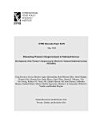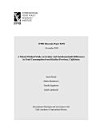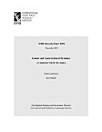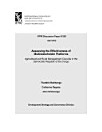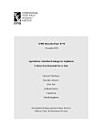Nutrition-sensitive agriculture diversification and dietary diversity: Panel data evidence from Tajikistan
Takeshima, Hiroyuki · Lambrecht, Isabel · Akramov, Kamiljon · Ergasheva, Tanzila
apr. 2024 · IFPRI Discussion Papers Bok 2249 · Intl Food Policy Res Inst
E-bok
48
Sider
family_home
Kvalifisert
info
reportVurderinger og anmeldelser blir ikke kontrollert Finn ut mer
Om denne e-boken
Nutrition-sensitive agricultural diversification continues to receive interest among developing country stakeholders as a viable option for achieving dual goals of poverty reduction and food/nutrition security improvements. Assessing the effectiveness of this strategy is also essential in countries like Tajikistan. We attempt to enrich the evidence base in this regard. We assess the linkages between household-level agricultural diversification and dietary diversity (both household- and individual-levels) using unique panel samples of households and individual women of reproductive ages in the Khatlon province. Using difference-in-difference propensity-score methods and panel fixed-effects instrumental variable regressions, we show that higher agricultural diversification together with greater overall production per worker and land at the household level leads to higher dietary diversity, particularly in areas with poor food market access. Typology analyses and crop-specific analyses suggest that vegetables, fruits, legumes/nuts/seeds, dairy products and eggs are particularly important commodities for which a farmer’s own production contributes to dietary diversity improvement. Furthermore, decomposition exercises within the subsistence farming framework suggest that nutritional returns and costs of agricultural diversification vary across households, and expected nutritional returns may be partly driving the adoption of agricultural diversification. In other words, households’ decisions to diversify agriculture may be partly driven by potential nutritional benefits associated with enhanced direct on-farm access to diverse food items rather than farm income growth alone. Our findings underscore the importance of supporting household farm diversification in Tajikistan to support improved nutrition intake, especially among those living in remote areas. In a low-income setting with limited local employment opportunities that is vulnerable to a wide range of external shocks, this will likely continue to be one of the most straightforward and realistic paths to improving household’s nutrition resilience.
Vurder denne e-boken
Fortell oss hva du mener.
Hvordan lese innhold
Smarttelefoner og nettbrett
Installer Google Play Bøker-appen for Android og iPad/iPhone. Den synkroniseres automatisk med kontoen din og lar deg lese både med og uten nett – uansett hvor du er.
Datamaskiner
Du kan lytte til lydbøker du har kjøpt på Google Play, i nettleseren på datamaskinen din.
Lesebrett og andre enheter
For å lese på lesebrett som Kobo eReader må du laste ned en fil og overføre den til enheten din. Følg den detaljerte veiledningen i brukerstøtten for å overføre filene til støttede lesebrett.




